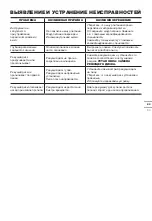
9
EN
by the workpiece, the edge of the wheel that is entering
into the pinch point can dig into the surface of the material
causing the wheel to climb out or kick out. The wheel may
either jump toward or away from the operator, depending
on direction of the wheel’s movement at the point of
pinching. Abrasive wheels may also break under these
conditions.
Kickback is the result of power tool misuse and/or
incorrect operating procedures or conditions and can be
avoided by taking proper precautions as given below.
a) Maintain a firm grip on the power tool and
position your body and arm to allow you to
resist kickback forces. Always use auxiliary
handle, if provided, for maximum control
over kickback or torque reaction during
start-up.
The operator can control torque reactions or kickback
forces, if proper precautions are taken.
b) Never place your hand near the rotating
accessory.
Accessory may kickback over your hand.
c) Do not position your body in line with the
rotating wheel.
Kickback will propel the tool in direction
opposite to the wheel’s movement at the point of snagging.
d) Use special care when working Corners,
sharp edges etc. Avoid bouncing and
snagging the accessory.
Corners, sharp edges or
bouncing have a tendency to snag the rotating accessory and
cause loss of control or kickback.
e) Do not attach a saw chain, woodcarving
blade, segmented diamond wheel with
a peripheral gap greater than 10 mm or
toothed saw blade.
Such blades create frequent kickback
and loss of control.
f) Do not “jam” the wheel or apply excessive
pressure. Do not attempt to make an
excessive depth of cut.
Overstressing the wheel
increases the loading and susceptibility to twisting or binding of the
wheel in the cut and the possibility of kickback or wheel breakage.
g) When wheel is binding or when interrupting
a cut for any reason, switch off the power
tool and hold the power tool motionless
until the wheel Comes to a complete stop.
Never attempt to remove the wheel from the
cut while the wheel is in motion otherwise
kickback may occur.
lnvestigate and take corrective
action to eliminate the cause of wheel binding.
h) Do not restart the cutting operation in the
workpiece. Let the wheel reach full speed
and carefully re-enter the cut.
The wheel may bind,
walk up or kickback if the power tool is restarted in the workpiece.
i ) Support panels or any oversized workpiece
to minimize the risk of wheel pinching and
kickback.
Large workpieces tend to sag under their own
weight. Supports must be placed under the workpiece near the
line of cut and near the edge of the workpiece on both sides of the
wheel.
j) Use extra caution when making a “pocket
cut” into existing walls or other blind areas.
The protruding wheel may cut gas or water pipes, electrical wiring
or objects that can cause kickback.
SYMBOLS
To reduce the risk of injury, user must read
instruction manual
Double insulation
Warning
Wear ear protection
Wear eye protection
Wear dust mask
Before any work on the machine itself, pull
the mains plug from the socket outlet.
Wear protective gloves
Wood
Metal
Aluminium
Incorrect
Correct
Lock
Unlock










































